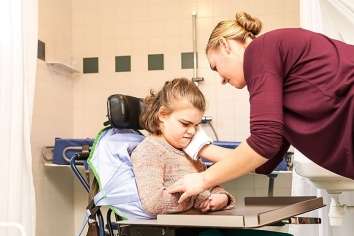Specialized nursing care needs assessment model developed for pediatric patients with complex conditions

Recent medical advances have resulted in increased survival of children with complex medical conditions (CMC), such as cerebral palsy, complex chromosomal anomalies, major congenital heart diseases and respiratory disease.
Healthcare services for this population are complex and include frequent transitions across inpatient, outpatient, subspecialty and community settings with poor coordination of care, contributing to increased hospital use. Quantifying severity of illness and intensity of service needs have typically used taxonomies designed for adult patients.
"There is not a published measure that is being used nationally that is specific for pediatrics," said Ann-Margaret Navarra PhD, CPNP-PC, an assistant professor at New York University College of Nursing (NYUCN). "Children with CMC utilize a lot of health care, yet it's not really clear what their needs are especially with regards to nursing."
Dr. Navarra, a pediatric nurse practitioner with a background in pediatrics and pediatric HIV, while working as a postdoc at Columbia University School of Nursing with Elaine L. Larson RN, PhD, FAAN, CIC, devised a nursing intensity measure that is specific for pediatrics and for use in pediatric long-term care facilities.
Using an unpublished intensity worksheet developed by pediatric nurses at one of the clinical sites as a starting point, the researchers tapped three pediatric care facilities for assistance in designing and testing the N-KICS tool (Nursing-Kids Intensity of Care Survey) to describe the intensity of nursing care for children with CMC. The N-KICS is detailed in a new study published in the Journal of Pediatric Nursing.
Three recursive rounds of testing spanning eighteen months assessed the reliability, validity, feasibility and acceptability of the N-KICS. The survey measures forty factors individually on a scale from one (not relevant to care needs) to four (very relevant to care needs). Amongst the forty items, vital signs, weight, observation, bathing, ambulation/mobility functionality, respiratory support and care, skin care, and behavior were assessed and taken into consideration for calculating nursing intensity.
After the final iterations of revising the N-KICS, the researchers implemented it at a pediatric long-term care facility with 97 beds; six nurse managers participated in the survey. High intensity scores were consistently observed for survey items representing nursing care related to infection control, medication administration, nutritional interventions, elimination (diaper changes), bathing, mouth care, management of seizures, and respiratory care such as chest therapy.
"Infection control was one of the higher intensity ratings, and this makes sense," said Dr. Navarra, "because these kids with chronic illness—they're in these facilities for a long time, interacting with a lot of professionals. Many have in-dwelling devices—whether it's an essential line or catheter, there are a lots of reasons why this could be. There's also, of course, the risk of hospital-acquired infection."
Although Dr. Navarra is a pediatric NP by training, she never worked in a pediatric long-term care facility and admits she was surprised by the level of intensity related to bathing, diaper changes, nutrition, and mouth care. These data contribute to a better understanding of the healthcare needs for this population in long-term care facilities.
"Considering that a large proportion of this population is discharged to home from acute care settings that's a big burden on the parents, especially with reported caregiver burden of 11- 20 hours weekly," says Dr. Navarra, noting a further application of the survey. Future testing of the N-KICS could include evaluation of service needs for families that would be helpful for discharge planning.
Dr. Navarra and the team of researchers also note the feasability and acceptability of the N-KICS.
"The average time to complete the N-KICS is ten minutes, and it was well received by the nursing staff in the facilities in which it was tested," said Dr. Navarra.
Since developing the N-KICS, it has been tested at eleven sites nationally. Those findings have not yet been published, but Dr. Navarra is hopeful that wide-spread adoption will foster more research.
"I think N-KICS represents, really, an initial first step to describe what the needs are for this population because it's a pediatric-specific tool," said Dr. Navarra. "We achieved our intent, which was really to look at what was needed so that there could be allocation of the best, optimal resources for these kids."















